Healthcare and Cultural Barriers: Aunty Letti's Australian Experience
VerifiedAdded on 2022/11/24
|6
|2492
|1
Report
AI Summary
This report examines the cultural barriers faced by Aunty Letti, an Aboriginal Australian, within the healthcare system. It highlights the systemic issues, including prejudice, language barriers, and differing cultural values, that impact her experience. The report analyzes how these factors contribute to healthcare disparities and affect Aunty Letti's access to and quality of care, particularly in the context of her diagnosis of renal failure and the need for dialysis. It explores the lack of cultural understanding and sensitivity from healthcare providers, the impact of discrimination, and the importance of culturally safe practices. The report emphasizes the need for healthcare systems to address these issues by promoting cultural competency, employing Indigenous staff, and fostering better communication and understanding to improve health outcomes for Aboriginal and Torres Strait Islander peoples. The analysis draws on various sources to illustrate the challenges and propose solutions for a more equitable and culturally sensitive healthcare environment.
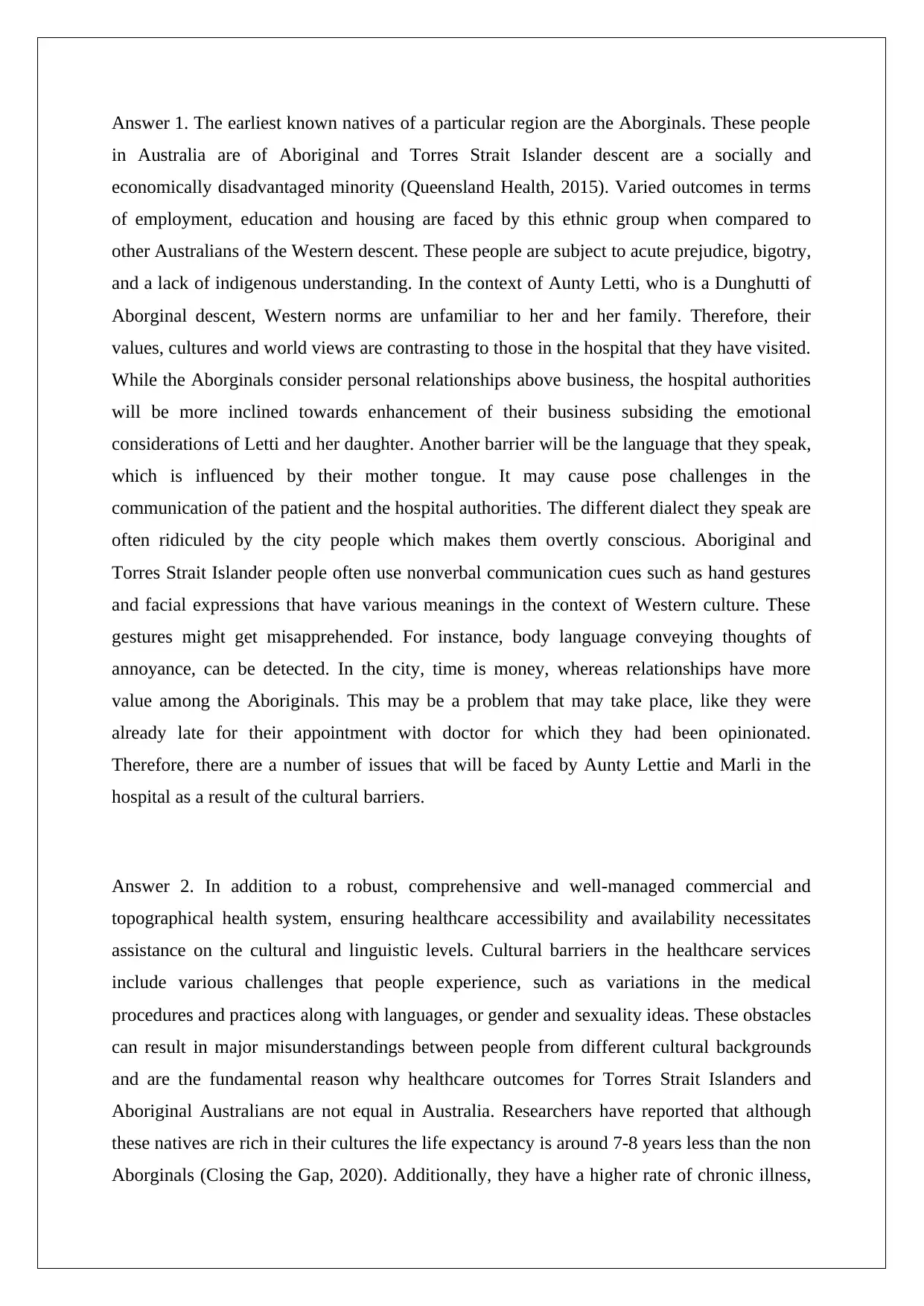
Answer 1. The earliest known natives of a particular region are the Aborginals. These people
in Australia are of Aboriginal and Torres Strait Islander descent are a socially and
economically disadvantaged minority (Queensland Health, 2015). Varied outcomes in terms
of employment, education and housing are faced by this ethnic group when compared to
other Australians of the Western descent. These people are subject to acute prejudice, bigotry,
and a lack of indigenous understanding. In the context of Aunty Letti, who is a Dunghutti of
Aborginal descent, Western norms are unfamiliar to her and her family. Therefore, their
values, cultures and world views are contrasting to those in the hospital that they have visited.
While the Aborginals consider personal relationships above business, the hospital authorities
will be more inclined towards enhancement of their business subsiding the emotional
considerations of Letti and her daughter. Another barrier will be the language that they speak,
which is influenced by their mother tongue. It may cause pose challenges in the
communication of the patient and the hospital authorities. The different dialect they speak are
often ridiculed by the city people which makes them overtly conscious. Aboriginal and
Torres Strait Islander people often use nonverbal communication cues such as hand gestures
and facial expressions that have various meanings in the context of Western culture. These
gestures might get misapprehended. For instance, body language conveying thoughts of
annoyance, can be detected. In the city, time is money, whereas relationships have more
value among the Aboriginals. This may be a problem that may take place, like they were
already late for their appointment with doctor for which they had been opinionated.
Therefore, there are a number of issues that will be faced by Aunty Lettie and Marli in the
hospital as a result of the cultural barriers.
Answer 2. In addition to a robust, comprehensive and well-managed commercial and
topographical health system, ensuring healthcare accessibility and availability necessitates
assistance on the cultural and linguistic levels. Cultural barriers in the healthcare services
include various challenges that people experience, such as variations in the medical
procedures and practices along with languages, or gender and sexuality ideas. These obstacles
can result in major misunderstandings between people from different cultural backgrounds
and are the fundamental reason why healthcare outcomes for Torres Strait Islanders and
Aboriginal Australians are not equal in Australia. Researchers have reported that although
these natives are rich in their cultures the life expectancy is around 7-8 years less than the non
Aborginals (Closing the Gap, 2020). Additionally, they have a higher rate of chronic illness,
in Australia are of Aboriginal and Torres Strait Islander descent are a socially and
economically disadvantaged minority (Queensland Health, 2015). Varied outcomes in terms
of employment, education and housing are faced by this ethnic group when compared to
other Australians of the Western descent. These people are subject to acute prejudice, bigotry,
and a lack of indigenous understanding. In the context of Aunty Letti, who is a Dunghutti of
Aborginal descent, Western norms are unfamiliar to her and her family. Therefore, their
values, cultures and world views are contrasting to those in the hospital that they have visited.
While the Aborginals consider personal relationships above business, the hospital authorities
will be more inclined towards enhancement of their business subsiding the emotional
considerations of Letti and her daughter. Another barrier will be the language that they speak,
which is influenced by their mother tongue. It may cause pose challenges in the
communication of the patient and the hospital authorities. The different dialect they speak are
often ridiculed by the city people which makes them overtly conscious. Aboriginal and
Torres Strait Islander people often use nonverbal communication cues such as hand gestures
and facial expressions that have various meanings in the context of Western culture. These
gestures might get misapprehended. For instance, body language conveying thoughts of
annoyance, can be detected. In the city, time is money, whereas relationships have more
value among the Aboriginals. This may be a problem that may take place, like they were
already late for their appointment with doctor for which they had been opinionated.
Therefore, there are a number of issues that will be faced by Aunty Lettie and Marli in the
hospital as a result of the cultural barriers.
Answer 2. In addition to a robust, comprehensive and well-managed commercial and
topographical health system, ensuring healthcare accessibility and availability necessitates
assistance on the cultural and linguistic levels. Cultural barriers in the healthcare services
include various challenges that people experience, such as variations in the medical
procedures and practices along with languages, or gender and sexuality ideas. These obstacles
can result in major misunderstandings between people from different cultural backgrounds
and are the fundamental reason why healthcare outcomes for Torres Strait Islanders and
Aboriginal Australians are not equal in Australia. Researchers have reported that although
these natives are rich in their cultures the life expectancy is around 7-8 years less than the non
Aborginals (Closing the Gap, 2020). Additionally, they have a higher rate of chronic illness,
Paraphrase This Document
Need a fresh take? Get an instant paraphrase of this document with our AI Paraphraser
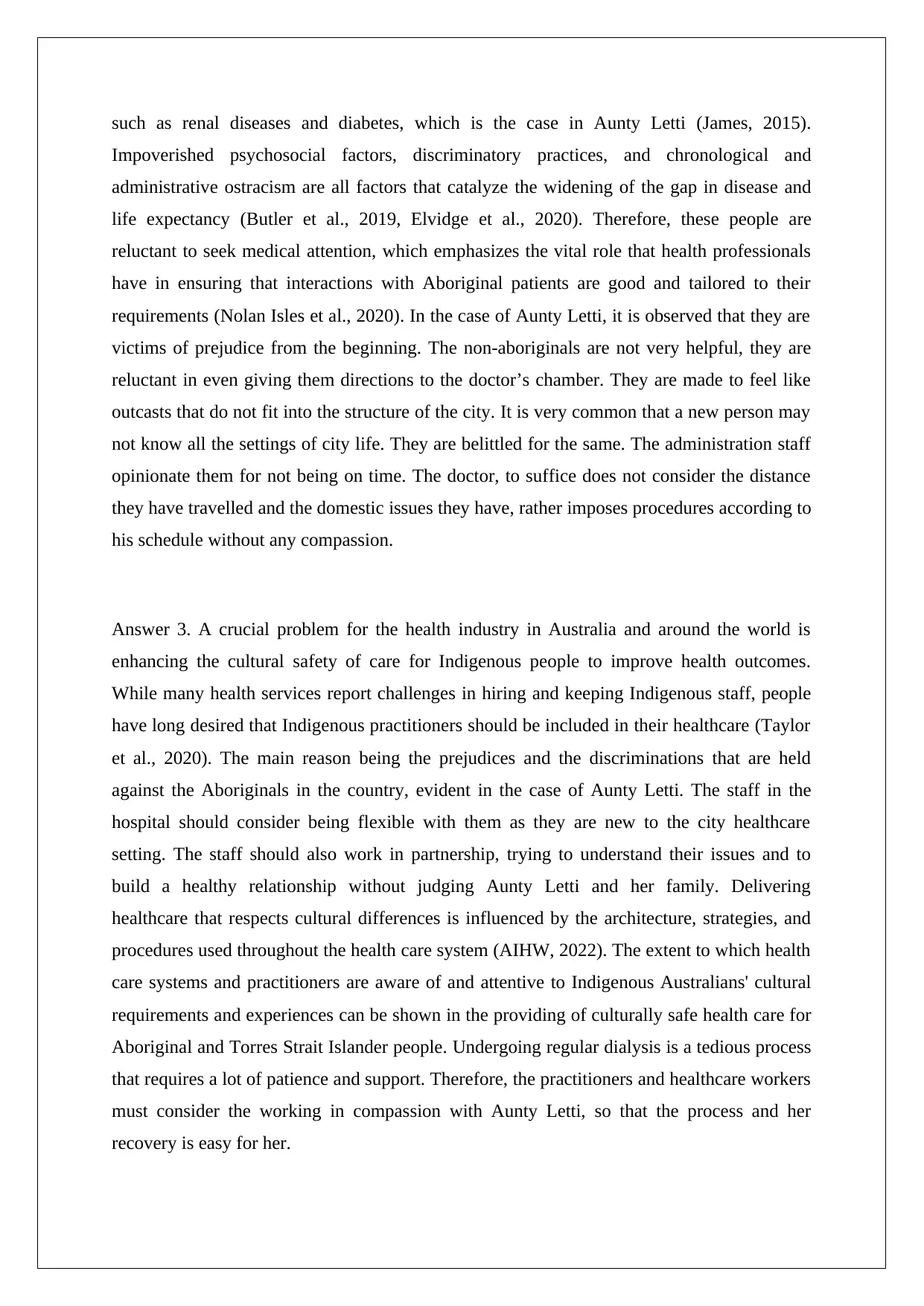
such as renal diseases and diabetes, which is the case in Aunty Letti (James, 2015).
Impoverished psychosocial factors, discriminatory practices, and chronological and
administrative ostracism are all factors that catalyze the widening of the gap in disease and
life expectancy (Butler et al., 2019, Elvidge et al., 2020). Therefore, these people are
reluctant to seek medical attention, which emphasizes the vital role that health professionals
have in ensuring that interactions with Aboriginal patients are good and tailored to their
requirements (Nolan Isles et al., 2020). In the case of Aunty Letti, it is observed that they are
victims of prejudice from the beginning. The non-aboriginals are not very helpful, they are
reluctant in even giving them directions to the doctor’s chamber. They are made to feel like
outcasts that do not fit into the structure of the city. It is very common that a new person may
not know all the settings of city life. They are belittled for the same. The administration staff
opinionate them for not being on time. The doctor, to suffice does not consider the distance
they have travelled and the domestic issues they have, rather imposes procedures according to
his schedule without any compassion.
Answer 3. A crucial problem for the health industry in Australia and around the world is
enhancing the cultural safety of care for Indigenous people to improve health outcomes.
While many health services report challenges in hiring and keeping Indigenous staff, people
have long desired that Indigenous practitioners should be included in their healthcare (Taylor
et al., 2020). The main reason being the prejudices and the discriminations that are held
against the Aboriginals in the country, evident in the case of Aunty Letti. The staff in the
hospital should consider being flexible with them as they are new to the city healthcare
setting. The staff should also work in partnership, trying to understand their issues and to
build a healthy relationship without judging Aunty Letti and her family. Delivering
healthcare that respects cultural differences is influenced by the architecture, strategies, and
procedures used throughout the health care system (AIHW, 2022). The extent to which health
care systems and practitioners are aware of and attentive to Indigenous Australians' cultural
requirements and experiences can be shown in the providing of culturally safe health care for
Aboriginal and Torres Strait Islander people. Undergoing regular dialysis is a tedious process
that requires a lot of patience and support. Therefore, the practitioners and healthcare workers
must consider the working in compassion with Aunty Letti, so that the process and her
recovery is easy for her.
Impoverished psychosocial factors, discriminatory practices, and chronological and
administrative ostracism are all factors that catalyze the widening of the gap in disease and
life expectancy (Butler et al., 2019, Elvidge et al., 2020). Therefore, these people are
reluctant to seek medical attention, which emphasizes the vital role that health professionals
have in ensuring that interactions with Aboriginal patients are good and tailored to their
requirements (Nolan Isles et al., 2020). In the case of Aunty Letti, it is observed that they are
victims of prejudice from the beginning. The non-aboriginals are not very helpful, they are
reluctant in even giving them directions to the doctor’s chamber. They are made to feel like
outcasts that do not fit into the structure of the city. It is very common that a new person may
not know all the settings of city life. They are belittled for the same. The administration staff
opinionate them for not being on time. The doctor, to suffice does not consider the distance
they have travelled and the domestic issues they have, rather imposes procedures according to
his schedule without any compassion.
Answer 3. A crucial problem for the health industry in Australia and around the world is
enhancing the cultural safety of care for Indigenous people to improve health outcomes.
While many health services report challenges in hiring and keeping Indigenous staff, people
have long desired that Indigenous practitioners should be included in their healthcare (Taylor
et al., 2020). The main reason being the prejudices and the discriminations that are held
against the Aboriginals in the country, evident in the case of Aunty Letti. The staff in the
hospital should consider being flexible with them as they are new to the city healthcare
setting. The staff should also work in partnership, trying to understand their issues and to
build a healthy relationship without judging Aunty Letti and her family. Delivering
healthcare that respects cultural differences is influenced by the architecture, strategies, and
procedures used throughout the health care system (AIHW, 2022). The extent to which health
care systems and practitioners are aware of and attentive to Indigenous Australians' cultural
requirements and experiences can be shown in the providing of culturally safe health care for
Aboriginal and Torres Strait Islander people. Undergoing regular dialysis is a tedious process
that requires a lot of patience and support. Therefore, the practitioners and healthcare workers
must consider the working in compassion with Aunty Letti, so that the process and her
recovery is easy for her.
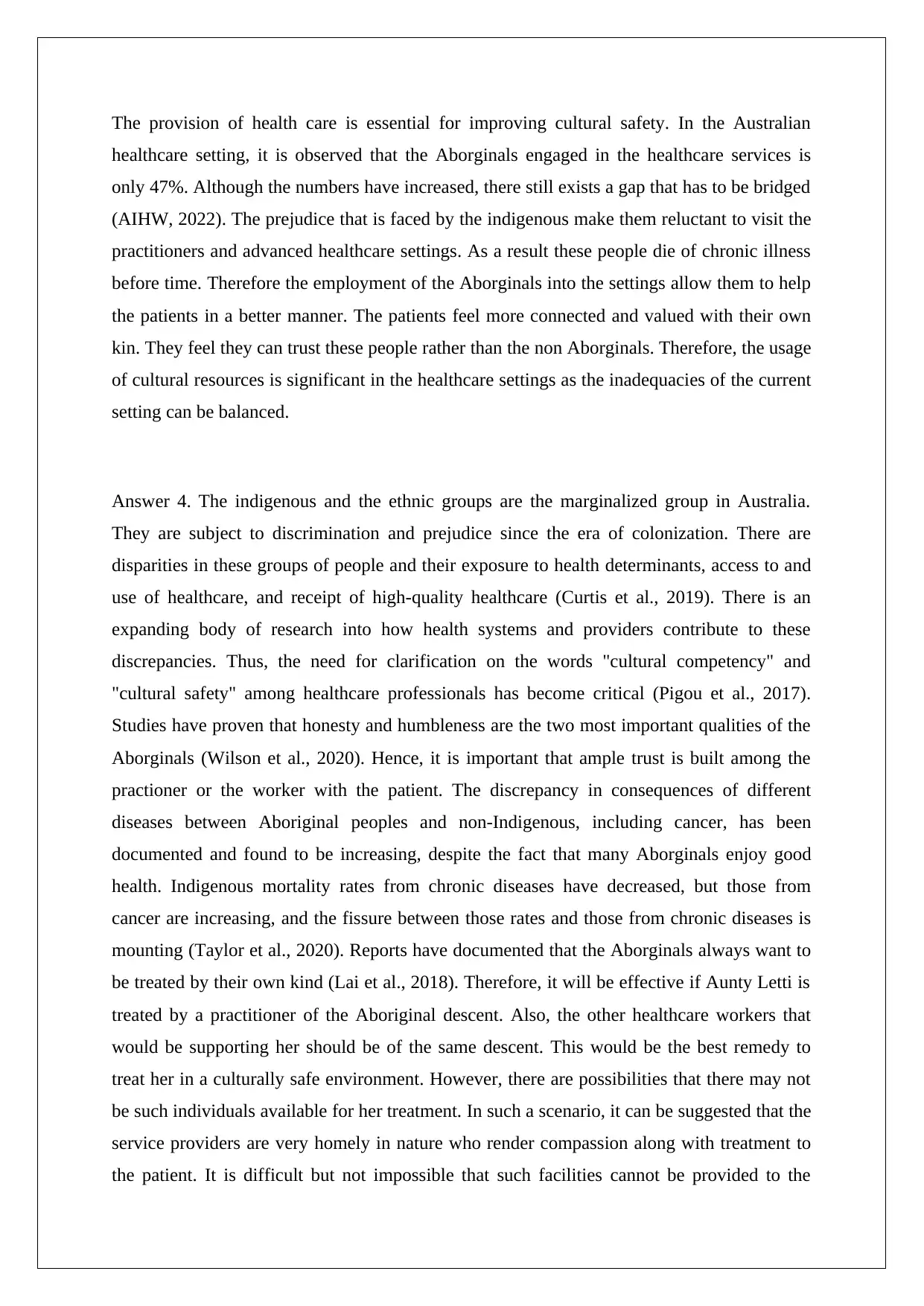
The provision of health care is essential for improving cultural safety. In the Australian
healthcare setting, it is observed that the Aborginals engaged in the healthcare services is
only 47%. Although the numbers have increased, there still exists a gap that has to be bridged
(AIHW, 2022). The prejudice that is faced by the indigenous make them reluctant to visit the
practitioners and advanced healthcare settings. As a result these people die of chronic illness
before time. Therefore the employment of the Aborginals into the settings allow them to help
the patients in a better manner. The patients feel more connected and valued with their own
kin. They feel they can trust these people rather than the non Aborginals. Therefore, the usage
of cultural resources is significant in the healthcare settings as the inadequacies of the current
setting can be balanced.
Answer 4. The indigenous and the ethnic groups are the marginalized group in Australia.
They are subject to discrimination and prejudice since the era of colonization. There are
disparities in these groups of people and their exposure to health determinants, access to and
use of healthcare, and receipt of high-quality healthcare (Curtis et al., 2019). There is an
expanding body of research into how health systems and providers contribute to these
discrepancies. Thus, the need for clarification on the words "cultural competency" and
"cultural safety" among healthcare professionals has become critical (Pigou et al., 2017).
Studies have proven that honesty and humbleness are the two most important qualities of the
Aborginals (Wilson et al., 2020). Hence, it is important that ample trust is built among the
practioner or the worker with the patient. The discrepancy in consequences of different
diseases between Aboriginal peoples and non-Indigenous, including cancer, has been
documented and found to be increasing, despite the fact that many Aborginals enjoy good
health. Indigenous mortality rates from chronic diseases have decreased, but those from
cancer are increasing, and the fissure between those rates and those from chronic diseases is
mounting (Taylor et al., 2020). Reports have documented that the Aborginals always want to
be treated by their own kind (Lai et al., 2018). Therefore, it will be effective if Aunty Letti is
treated by a practitioner of the Aboriginal descent. Also, the other healthcare workers that
would be supporting her should be of the same descent. This would be the best remedy to
treat her in a culturally safe environment. However, there are possibilities that there may not
be such individuals available for her treatment. In such a scenario, it can be suggested that the
service providers are very homely in nature who render compassion along with treatment to
the patient. It is difficult but not impossible that such facilities cannot be provided to the
healthcare setting, it is observed that the Aborginals engaged in the healthcare services is
only 47%. Although the numbers have increased, there still exists a gap that has to be bridged
(AIHW, 2022). The prejudice that is faced by the indigenous make them reluctant to visit the
practitioners and advanced healthcare settings. As a result these people die of chronic illness
before time. Therefore the employment of the Aborginals into the settings allow them to help
the patients in a better manner. The patients feel more connected and valued with their own
kin. They feel they can trust these people rather than the non Aborginals. Therefore, the usage
of cultural resources is significant in the healthcare settings as the inadequacies of the current
setting can be balanced.
Answer 4. The indigenous and the ethnic groups are the marginalized group in Australia.
They are subject to discrimination and prejudice since the era of colonization. There are
disparities in these groups of people and their exposure to health determinants, access to and
use of healthcare, and receipt of high-quality healthcare (Curtis et al., 2019). There is an
expanding body of research into how health systems and providers contribute to these
discrepancies. Thus, the need for clarification on the words "cultural competency" and
"cultural safety" among healthcare professionals has become critical (Pigou et al., 2017).
Studies have proven that honesty and humbleness are the two most important qualities of the
Aborginals (Wilson et al., 2020). Hence, it is important that ample trust is built among the
practioner or the worker with the patient. The discrepancy in consequences of different
diseases between Aboriginal peoples and non-Indigenous, including cancer, has been
documented and found to be increasing, despite the fact that many Aborginals enjoy good
health. Indigenous mortality rates from chronic diseases have decreased, but those from
cancer are increasing, and the fissure between those rates and those from chronic diseases is
mounting (Taylor et al., 2020). Reports have documented that the Aborginals always want to
be treated by their own kind (Lai et al., 2018). Therefore, it will be effective if Aunty Letti is
treated by a practitioner of the Aboriginal descent. Also, the other healthcare workers that
would be supporting her should be of the same descent. This would be the best remedy to
treat her in a culturally safe environment. However, there are possibilities that there may not
be such individuals available for her treatment. In such a scenario, it can be suggested that the
service providers are very homely in nature who render compassion along with treatment to
the patient. It is difficult but not impossible that such facilities cannot be provided to the
⊘ This is a preview!⊘
Do you want full access?
Subscribe today to unlock all pages.

Trusted by 1+ million students worldwide
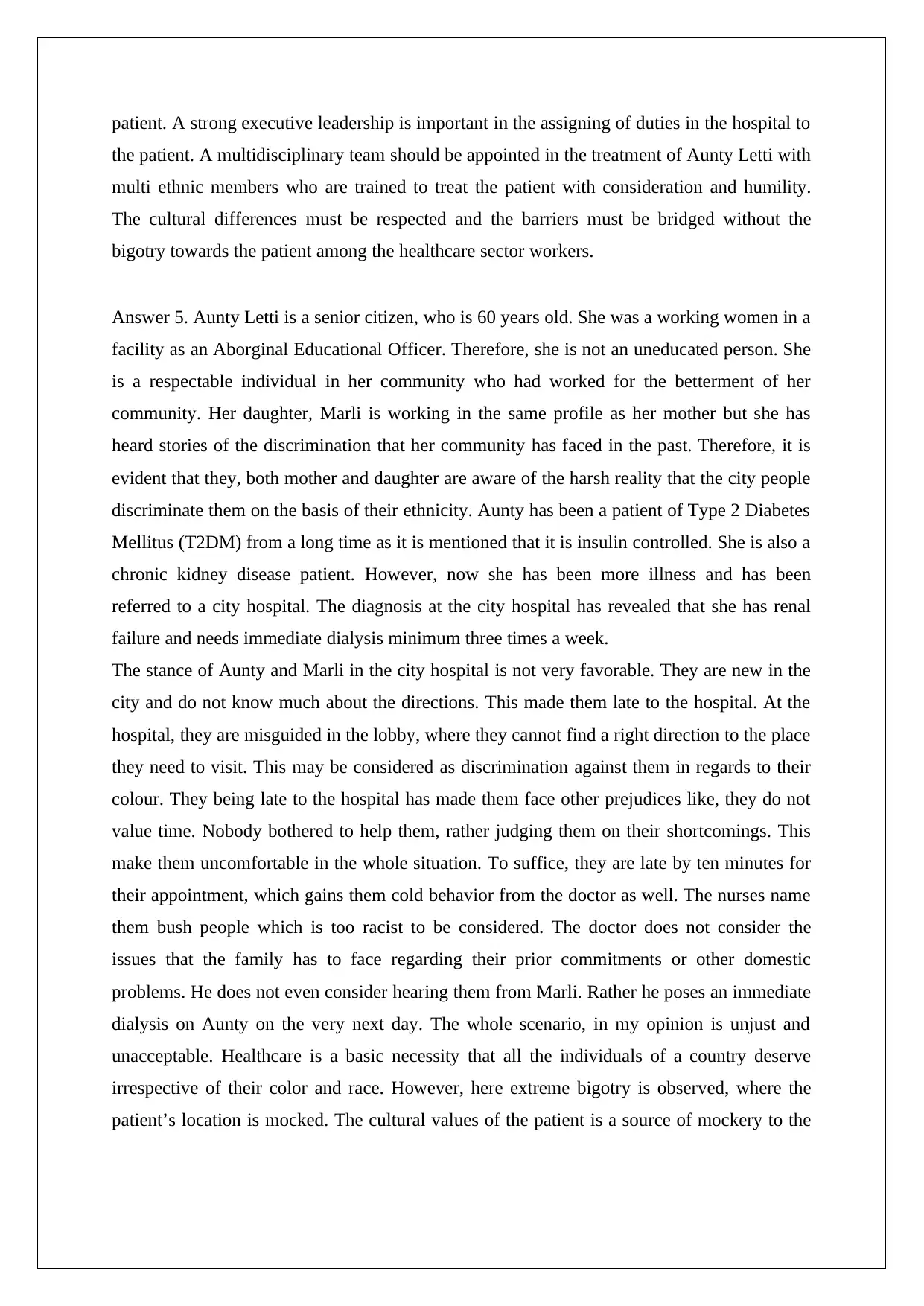
patient. A strong executive leadership is important in the assigning of duties in the hospital to
the patient. A multidisciplinary team should be appointed in the treatment of Aunty Letti with
multi ethnic members who are trained to treat the patient with consideration and humility.
The cultural differences must be respected and the barriers must be bridged without the
bigotry towards the patient among the healthcare sector workers.
Answer 5. Aunty Letti is a senior citizen, who is 60 years old. She was a working women in a
facility as an Aborginal Educational Officer. Therefore, she is not an uneducated person. She
is a respectable individual in her community who had worked for the betterment of her
community. Her daughter, Marli is working in the same profile as her mother but she has
heard stories of the discrimination that her community has faced in the past. Therefore, it is
evident that they, both mother and daughter are aware of the harsh reality that the city people
discriminate them on the basis of their ethnicity. Aunty has been a patient of Type 2 Diabetes
Mellitus (T2DM) from a long time as it is mentioned that it is insulin controlled. She is also a
chronic kidney disease patient. However, now she has been more illness and has been
referred to a city hospital. The diagnosis at the city hospital has revealed that she has renal
failure and needs immediate dialysis minimum three times a week.
The stance of Aunty and Marli in the city hospital is not very favorable. They are new in the
city and do not know much about the directions. This made them late to the hospital. At the
hospital, they are misguided in the lobby, where they cannot find a right direction to the place
they need to visit. This may be considered as discrimination against them in regards to their
colour. They being late to the hospital has made them face other prejudices like, they do not
value time. Nobody bothered to help them, rather judging them on their shortcomings. This
make them uncomfortable in the whole situation. To suffice, they are late by ten minutes for
their appointment, which gains them cold behavior from the doctor as well. The nurses name
them bush people which is too racist to be considered. The doctor does not consider the
issues that the family has to face regarding their prior commitments or other domestic
problems. He does not even consider hearing them from Marli. Rather he poses an immediate
dialysis on Aunty on the very next day. The whole scenario, in my opinion is unjust and
unacceptable. Healthcare is a basic necessity that all the individuals of a country deserve
irrespective of their color and race. However, here extreme bigotry is observed, where the
patient’s location is mocked. The cultural values of the patient is a source of mockery to the
the patient. A multidisciplinary team should be appointed in the treatment of Aunty Letti with
multi ethnic members who are trained to treat the patient with consideration and humility.
The cultural differences must be respected and the barriers must be bridged without the
bigotry towards the patient among the healthcare sector workers.
Answer 5. Aunty Letti is a senior citizen, who is 60 years old. She was a working women in a
facility as an Aborginal Educational Officer. Therefore, she is not an uneducated person. She
is a respectable individual in her community who had worked for the betterment of her
community. Her daughter, Marli is working in the same profile as her mother but she has
heard stories of the discrimination that her community has faced in the past. Therefore, it is
evident that they, both mother and daughter are aware of the harsh reality that the city people
discriminate them on the basis of their ethnicity. Aunty has been a patient of Type 2 Diabetes
Mellitus (T2DM) from a long time as it is mentioned that it is insulin controlled. She is also a
chronic kidney disease patient. However, now she has been more illness and has been
referred to a city hospital. The diagnosis at the city hospital has revealed that she has renal
failure and needs immediate dialysis minimum three times a week.
The stance of Aunty and Marli in the city hospital is not very favorable. They are new in the
city and do not know much about the directions. This made them late to the hospital. At the
hospital, they are misguided in the lobby, where they cannot find a right direction to the place
they need to visit. This may be considered as discrimination against them in regards to their
colour. They being late to the hospital has made them face other prejudices like, they do not
value time. Nobody bothered to help them, rather judging them on their shortcomings. This
make them uncomfortable in the whole situation. To suffice, they are late by ten minutes for
their appointment, which gains them cold behavior from the doctor as well. The nurses name
them bush people which is too racist to be considered. The doctor does not consider the
issues that the family has to face regarding their prior commitments or other domestic
problems. He does not even consider hearing them from Marli. Rather he poses an immediate
dialysis on Aunty on the very next day. The whole scenario, in my opinion is unjust and
unacceptable. Healthcare is a basic necessity that all the individuals of a country deserve
irrespective of their color and race. However, here extreme bigotry is observed, where the
patient’s location is mocked. The cultural values of the patient is a source of mockery to the
Paraphrase This Document
Need a fresh take? Get an instant paraphrase of this document with our AI Paraphraser
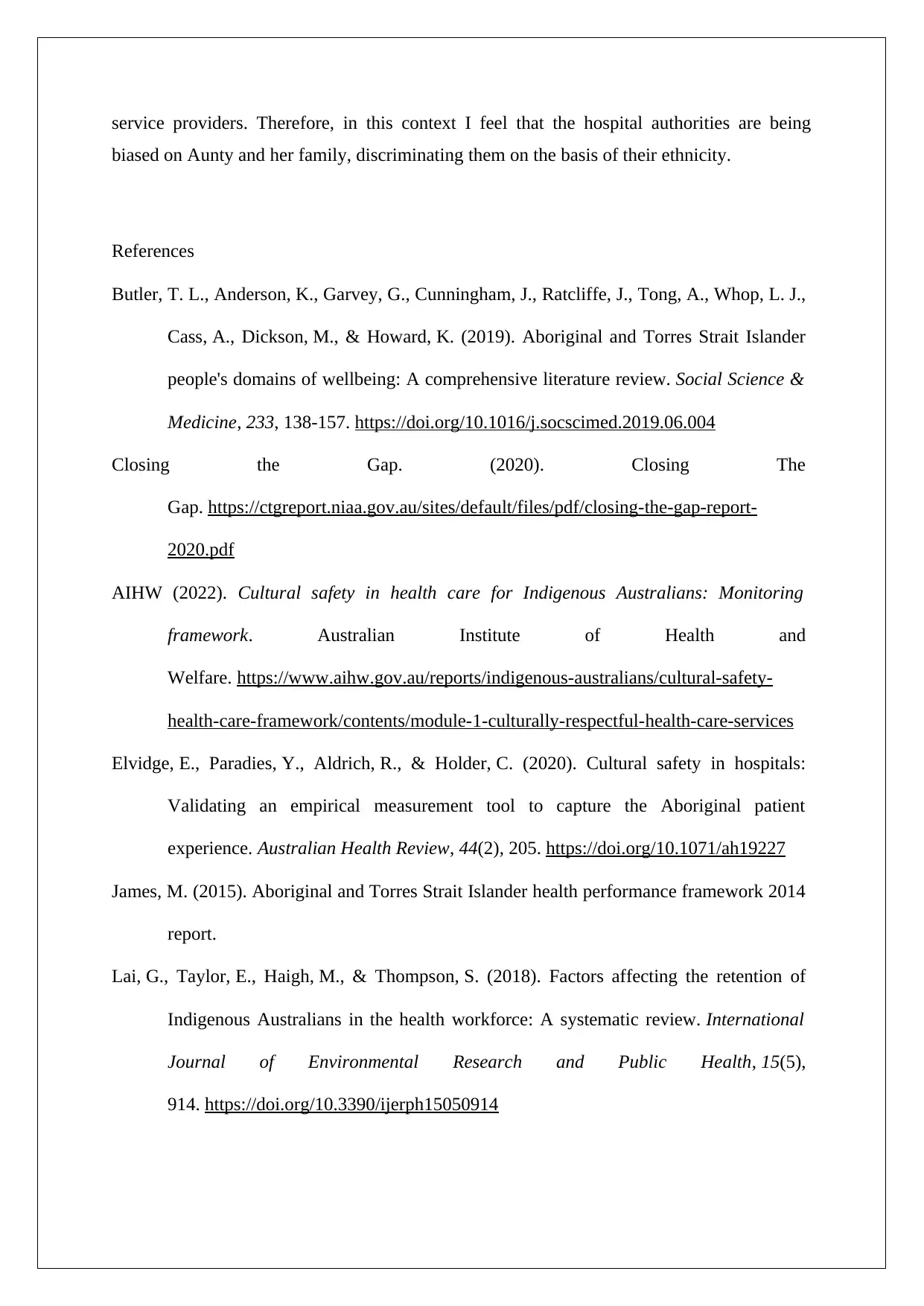
service providers. Therefore, in this context I feel that the hospital authorities are being
biased on Aunty and her family, discriminating them on the basis of their ethnicity.
References
Butler, T. L., Anderson, K., Garvey, G., Cunningham, J., Ratcliffe, J., Tong, A., Whop, L. J.,
Cass, A., Dickson, M., & Howard, K. (2019). Aboriginal and Torres Strait Islander
people's domains of wellbeing: A comprehensive literature review. Social Science &
Medicine, 233, 138-157. https://doi.org/10.1016/j.socscimed.2019.06.004
Closing the Gap. (2020). Closing The
Gap. https://ctgreport.niaa.gov.au/sites/default/files/pdf/closing-the-gap-report-
2020.pdf
AIHW (2022). Cultural safety in health care for Indigenous Australians: Monitoring
framework. Australian Institute of Health and
Welfare. https://www.aihw.gov.au/reports/indigenous-australians/cultural-safety-
health-care-framework/contents/module-1-culturally-respectful-health-care-services
Elvidge, E., Paradies, Y., Aldrich, R., & Holder, C. (2020). Cultural safety in hospitals:
Validating an empirical measurement tool to capture the Aboriginal patient
experience. Australian Health Review, 44(2), 205. https://doi.org/10.1071/ah19227
James, M. (2015). Aboriginal and Torres Strait Islander health performance framework 2014
report.
Lai, G., Taylor, E., Haigh, M., & Thompson, S. (2018). Factors affecting the retention of
Indigenous Australians in the health workforce: A systematic review. International
Journal of Environmental Research and Public Health, 15(5),
914. https://doi.org/10.3390/ijerph15050914
biased on Aunty and her family, discriminating them on the basis of their ethnicity.
References
Butler, T. L., Anderson, K., Garvey, G., Cunningham, J., Ratcliffe, J., Tong, A., Whop, L. J.,
Cass, A., Dickson, M., & Howard, K. (2019). Aboriginal and Torres Strait Islander
people's domains of wellbeing: A comprehensive literature review. Social Science &
Medicine, 233, 138-157. https://doi.org/10.1016/j.socscimed.2019.06.004
Closing the Gap. (2020). Closing The
Gap. https://ctgreport.niaa.gov.au/sites/default/files/pdf/closing-the-gap-report-
2020.pdf
AIHW (2022). Cultural safety in health care for Indigenous Australians: Monitoring
framework. Australian Institute of Health and
Welfare. https://www.aihw.gov.au/reports/indigenous-australians/cultural-safety-
health-care-framework/contents/module-1-culturally-respectful-health-care-services
Elvidge, E., Paradies, Y., Aldrich, R., & Holder, C. (2020). Cultural safety in hospitals:
Validating an empirical measurement tool to capture the Aboriginal patient
experience. Australian Health Review, 44(2), 205. https://doi.org/10.1071/ah19227
James, M. (2015). Aboriginal and Torres Strait Islander health performance framework 2014
report.
Lai, G., Taylor, E., Haigh, M., & Thompson, S. (2018). Factors affecting the retention of
Indigenous Australians in the health workforce: A systematic review. International
Journal of Environmental Research and Public Health, 15(5),
914. https://doi.org/10.3390/ijerph15050914
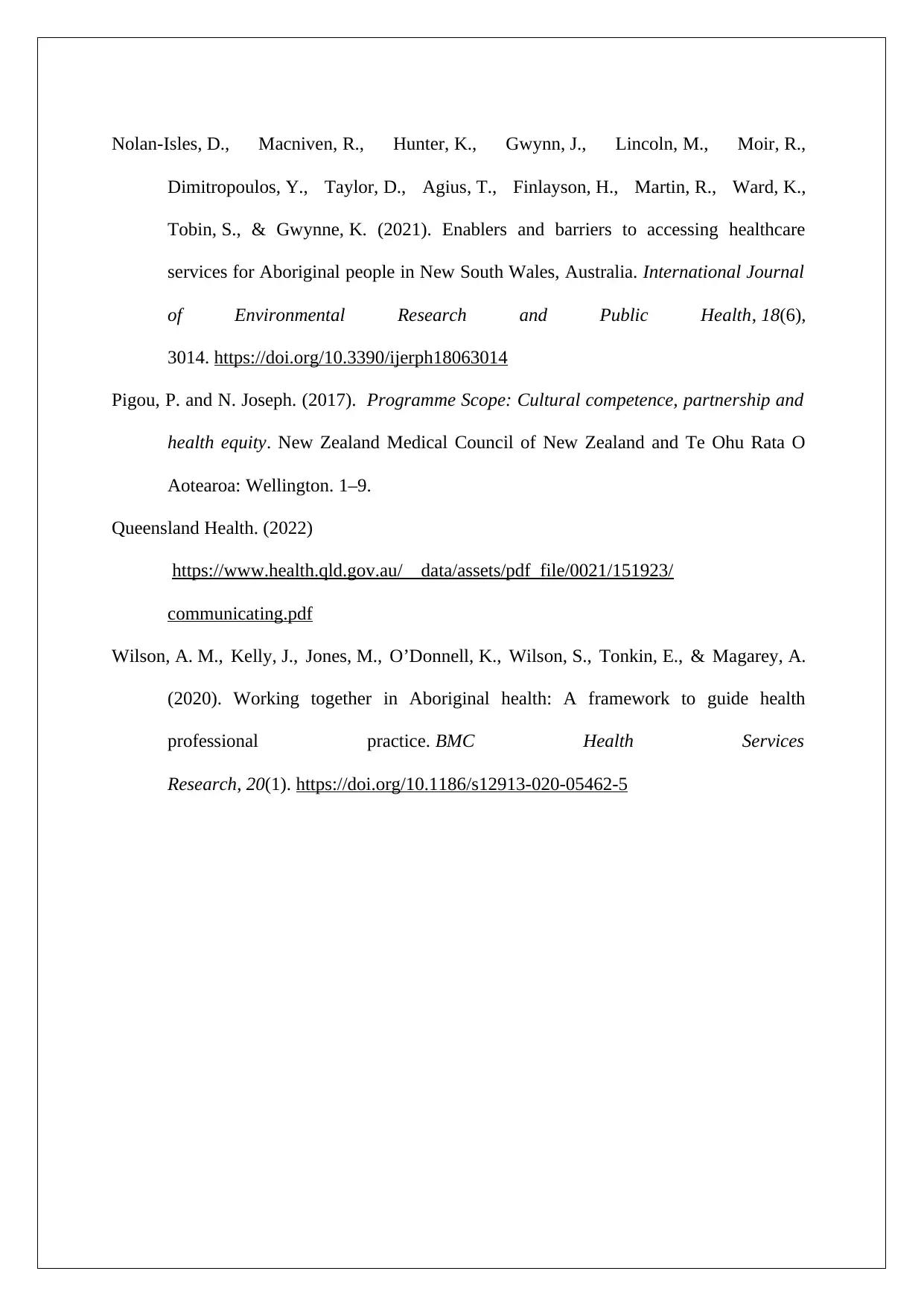
Nolan-Isles, D., Macniven, R., Hunter, K., Gwynn, J., Lincoln, M., Moir, R.,
Dimitropoulos, Y., Taylor, D., Agius, T., Finlayson, H., Martin, R., Ward, K.,
Tobin, S., & Gwynne, K. (2021). Enablers and barriers to accessing healthcare
services for Aboriginal people in New South Wales, Australia. International Journal
of Environmental Research and Public Health, 18(6),
3014. https://doi.org/10.3390/ijerph18063014
Pigou, P. and N. Joseph. (2017). Programme Scope: Cultural competence, partnership and
health equity. New Zealand Medical Council of New Zealand and Te Ohu Rata O
Aotearoa: Wellington. 1–9.
Queensland Health. (2022)
https://www.health.qld.gov.au/__data/assets/pdf_file/0021/151923/
communicating.pdf
Wilson, A. M., Kelly, J., Jones, M., O’Donnell, K., Wilson, S., Tonkin, E., & Magarey, A.
(2020). Working together in Aboriginal health: A framework to guide health
professional practice. BMC Health Services
Research, 20(1). https://doi.org/10.1186/s12913-020-05462-5
Dimitropoulos, Y., Taylor, D., Agius, T., Finlayson, H., Martin, R., Ward, K.,
Tobin, S., & Gwynne, K. (2021). Enablers and barriers to accessing healthcare
services for Aboriginal people in New South Wales, Australia. International Journal
of Environmental Research and Public Health, 18(6),
3014. https://doi.org/10.3390/ijerph18063014
Pigou, P. and N. Joseph. (2017). Programme Scope: Cultural competence, partnership and
health equity. New Zealand Medical Council of New Zealand and Te Ohu Rata O
Aotearoa: Wellington. 1–9.
Queensland Health. (2022)
https://www.health.qld.gov.au/__data/assets/pdf_file/0021/151923/
communicating.pdf
Wilson, A. M., Kelly, J., Jones, M., O’Donnell, K., Wilson, S., Tonkin, E., & Magarey, A.
(2020). Working together in Aboriginal health: A framework to guide health
professional practice. BMC Health Services
Research, 20(1). https://doi.org/10.1186/s12913-020-05462-5
⊘ This is a preview!⊘
Do you want full access?
Subscribe today to unlock all pages.

Trusted by 1+ million students worldwide
1 out of 6
Related Documents
Your All-in-One AI-Powered Toolkit for Academic Success.
+13062052269
info@desklib.com
Available 24*7 on WhatsApp / Email
![[object Object]](/_next/static/media/star-bottom.7253800d.svg)
Unlock your academic potential
Copyright © 2020–2025 A2Z Services. All Rights Reserved. Developed and managed by ZUCOL.





